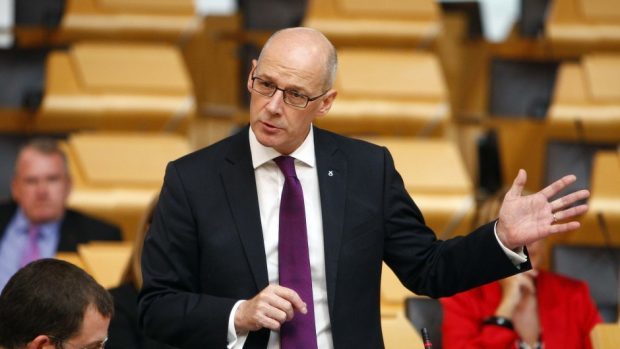John Swinney yesterday said controversial primary one tests will continue despite a review reporting they made children “tired and bored”.
The Education Secretary once again defied opposition calls to scrap the tests for four and five-year-olds in a statement to the Scottish Parliament.
He addressed MPs as a Scottish Government review by literacy expert David Reedy was published.
Mr Swinney said that there was “scant evidence” of young pupils becoming upset during the assessment process.
In the surveys and interviews that provided evidence to his review, Mr Reedy said there were indeed “very few” comments about children becoming upset and tearful.
Instead, there were rather more comments that children “became tired and bored”.
Mr Reedy did, however, conclude that P1 tests had the “potential to play a significant role in informing and enhancing teachers’ professional judgments” about how pupils are performing.
The review said the tests should be “continued with modification”, including safeguards to prevent any “drift towards high stakes” testing.
Defying calls to scrap the testing, the education secretary said there would be “important modifications” made to the Scottish National Standardised Assessments (SNSA), including new guidelines on their use.
Mr Swinney said: “I do not suggest this review has delivered an unqualified green light to the Scottish Government in terms of P1 assessments.
“I accept that there is work to be done, but believe with the improvements proposed we can move forward in the correct direction.”
The assessments were introduced by the Scottish Government in 2017, as part of efforts to close the attainment gap, with youngsters being tested in P1, P4, P7 and S3.
However, their use on the very youngest schoolchildren has been controversial, with unions claiming some youngsters had been reduced to tears during the testing process.
Last September, opposition parties combined in Holyrood to defeat the government by 63 to 61 and demand the tests were halted.
The vote, however, was non-binding allowing Mr Swinney to press ahead with the tests.
Conservative education spokeswoman Liz Smith said that the Education Secretary “has his head in the sand”.
Ms Smith said: “He refuses to get the message that the Scottish Parliament voted to halt the P1 tests because all the opposition parties were listening to the concerns expressed by primary school teachers, parents and educational experts.
“They told us that the purpose of the tests was unclear and that there was no evidence that they provided any added educational benefit.
“What has been published today does not answer these basic concerns.”
Labour education spokesman Iain Gray added: “It remains an act of supreme arrogance for John Swinney to continue to defy the will of the Scottish Parliament.”










